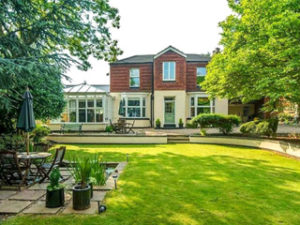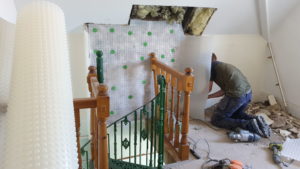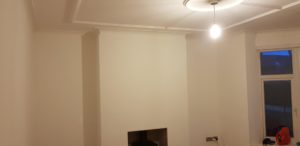Do I Need Monocouche Render or Thincoat Render?
What is monocouche render, and what is thin coat render? The choice of monocouche render or a thincoat render can affect the timescale, appearance and future maintenance of your build. If you are specifying products for a build or renovation, or engaging contractors and applicators you need to know the difference between these finishing materials.
What is Monocouche render?
Monocouche renders are an exterior finish applied to buildings that provides decoration and protection from the elements. Monocouche render always comes pre-bagged in bags of dry powder. The terms ‘through colour render’ and ‘scraped finish render’ are associated with monocouche as the dry powder will have colour pigments included. This means that, once mixed and applied, the colour will not only be on the face of the render, but consistent through the body of the render itself. Monocouche, once left to dry, is then scraped back with the use of a nail float and I bar to achieve the correct finish. You only have to add clean water when preparing the render for application.
What is monocouche made of?
A monocouche render formulation is defined by the use of ordinary white Portland cement as a binder, as a white base enables the manufacturer to add pigment to achieve a range of specific colours. Standard renders are formulated with ordinary Portland cement which is grey, so they cannot be pigmented successfully. This factor marks the biggest difference with modern and traditional renders. Other additives are also added into the render such as silicone or mica to achieve additional properties that will differ from manufacturer to manufacturer. Monocouche comes in 18 stock colours,
What does Monocouche mean?
The French term monocouche which translates to ‘one coat’ has been adopted by the European render industry, primarily to distinguish modern renders and application methods from traditional renders such as sand and cement.
What surfaces can monocouche be applied to?
Monocouche render can be applied to a number of different substrates, but in some instances you may need a pre-treatment to control the level of water suction. For example, lightweight, aerated blocks have high water suction rates so need either a lime cement primer or basecoat such as applied before the coat of monocouche. Brick or concrete substrates are low in suction so will need an application of Prep basecoat first, to provide an adequate key for the monocouche render to bind to.
How is monocouche applied?
The render should always be applied by someone who is competent and confident in using it. Monocouche can be applied by hand or machine. The finished thickness of the render should be around 15mm in depth, as this gives adequate protection to the substrate and will prevent the horizontal and vertical joints in the blockwork from grinning through the finished face of the render. Once any pre preparation of the wall has been completed e.g. beading or priming, the monocouche can then be plastered to the wall, usually at 8mm thick with mesh embedded where applicable. This is called the ‘first pass’. Then a second coat ‘second pass’ can be applied over the first while it is still curing. This is what’s called a ‘monolithic bond’. The second pass is around 2 to 3mm in depth past the bead, so it can be scraped back to the finished depth. This secondary coat needs to be flattened and ruled with a straight edge. Depending on the temperature and weather conditions the monocouche can take from 5 to 36 hours to dry. Then it can be scraped back using an I bar and nail float to achieve the finished thickness and texture. A simple soft brush is used a final touch to remove any of the loose dust particles of render lodged in the surface. The benefits of monocouche over traditional sand and cement:
- Complete in one coat, two passes
- Through coloured, so no need for masonry paint
- Flexible and less prone to cracking
What is thin coat render?
Thin coat render is primarily a decorative finish that can be applied internally or externally. It provides an attractive finish to a variety of facades and substrates, it is low maintenance, waterproof, lightweight and breathable. Thin coat render usually comes in a factory-batched tub ready to use. It has the desired colour already incorporated into it, so post painting will not be required. Thin coat is very popular around Europe and is still used today across the whole of the continent today.
How is thin coat render applied?
Thin coat can also be applied by hand or machine but should be undertaken by someone who has experience and knowledge in using it. First, if applying to a particular system such as timber frame or external wall insulation, use a high polymer base coat with a mesh reinforcement. Take time to ensure it is flat and uniform. There should be no trowel marks on the surface and the thickness should be consistent. Then paint a coat of primer onto the basecoat once dry. The primer is generally the same colour as the top coat. Once the primer is dry, after about a day, apply top coat render using a steel trowel to a thickness the same as the aggregate size, usually 1.5mm. The aggregate size will vary but the concept will stay then same. When relatively flat use a PVC float over the surface to achieve the desired finish.
What surfaces can thin coat render be applied to?
Thin coat renders may be applied to primed, new or old substrates. Externally, they may be applied to suitably smooth and flat surfaces of cement-based rendering, fair faced concrete, exterior grade composition, rain screen cladding facades (timber frame or steel frame) and external wall insulation systems. Additional surfaces (for internal application only), are suitably smooth and flat plasters, gypsum finishing plasters, dry lining and suitable insulating boards. Silicon thin coat renders are ideal for use in areas of high exposure to the elements such as coastal properties, or areas close to woodland where algae is a constant pain, as any build-up on the face can be cleaned off with a pressure washer. A mineral thin coat render, such as mineral rend or eco rend can be applied in temperatures as low as 1 degree for application in the colder months.
Benefits of thin coat render:
- Ideal for extreme weather conditions, coastal or woodland
- Easy to clean with just a pressure washer
- Can be applied to a variety of substrates
- No need to paint
Monochouche or thin coat – what do you need for your project?
Take into consideration the substrate, location of the building, ongoing maintenance and time before choosing which render is best for you.



